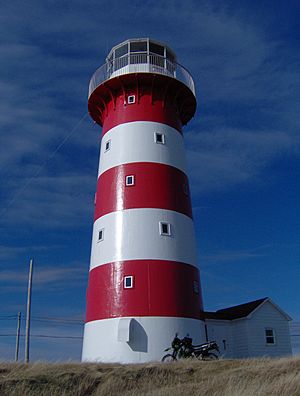Cape Pine Light facts for kids
 |
|
| Cape Pine Lighthouse | |
|
|
|
| Location | Cape Pine Avalon Peninsula Newfoundland and Labrador Canada |
|---|---|
| Coordinates | 46°37′01.7″N 53°31′55.6″W / 46.617139°N 53.532111°W |
| Year first constructed | 1851 |
| Construction | cast iron tower |
| Tower shape | cylindrical tower with balcony and lantern |
| Markings / pattern | tower with white and red horizontal bands, white lantern |
| Height | 15 metres (49 ft) |
| Focal height | 96 metres (315 ft) |
| Range | 16 nautical miles (30 km; 18 mi) |
| Characteristic | Fl W 5s. |
| Fog signal | blast every 60s. |
| Admiralty number | H0440 |
| CHS number | CCG 6 |
| NGA number | 1920 |
| ARLHS number | CAN-653 |
The Cape Pine Light is a historic lighthouse located on Cape Pine in Newfoundland and Labrador, Canada. It was built in 1851 by a British architect and engineer named Alexander Gordon. This lighthouse has helped guide ships safely for over 170 years.
Contents
What Makes This Lighthouse Special?
The Cape Pine Lighthouse is a unique structure. It is a prefabricated (meaning it was built in sections somewhere else and then put together on site) cylindrical tower made of cast iron. The tower is painted white with bright red stripes. The last time it got a full paint job was in 2007.
How the Light Works
The lighthouse sends out a white flash of light every 5 seconds. This is called its light characteristic. When the weather is foggy, a loud fog horn also sounds every 60 seconds to warn ships. The Canadian Coast Guard takes care of the lighthouse and still has a person, called a keeper, living there to operate it.
A National Historic Site
The Cape Pine Lighthouse was recognized as a National Historic Site in 1974. This means it's an important part of Canada's history. The first lighthouse keeper actually lived inside the lighthouse. But it was hard to keep warm, so a separate house was built for the keeper in 1851. That original house was replaced with a more modern one in the 1950s.
The lighthouse is about 25 kilometers (15 miles) southwest of a town called Trepassey. You can get there by driving about 8 kilometers (5 miles) on a gravel road. It stands proudly on the edge of a tall, black slate cliff that is 315 feet high.
Why Was the Lighthouse Built?
Before 1850, many ships and lives were lost near Cape Pine. This area is at the very southern tip of the Avalon Peninsula. It's also at the eastern entrance to St. Mary's Bay. The waters here often have thick fog and strong ocean currents. This made it very dangerous for fishermen and ships traveling to Europe.
A Dangerous Journey
For example, after the War of 1812, a British troop ship called HMS Harpooner was heading to England. It crashed in a dense fog near Cape Pine, and over 350 people died. More ships were lost in this area during the 1820s and 1830s.
Asking for Help
Because of these dangers, the local government in Newfoundland, called the House of Assembly, kept asking the British government for help. They wanted a lighthouse built at Cape Pine. In 1847, their request was finally approved. The Cape Pine Lighthouse was the first prefabricated cast iron lighthouse in Newfoundland. Many more like it were built later. In the 20th century, lighthouses started being built with reinforced concrete instead.
Lighthouse Keepers
Lighthouse keepers are the people who live at the lighthouse and make sure it works properly. They are very important for keeping ships safe. Here are some of the dedicated keepers who have worked at Cape Pine:
- Henry Hearder (1851–1866)
- George Hewitt (1866-1898)
- George J. Hewitt (1898–1935)
- George T. Hewitt (1935-1959)
- Valentine Hewitt (1959–1973)
- Michael Myrick (1973-?)
- Tom Finlay, Peter Myrick (1996-?)


